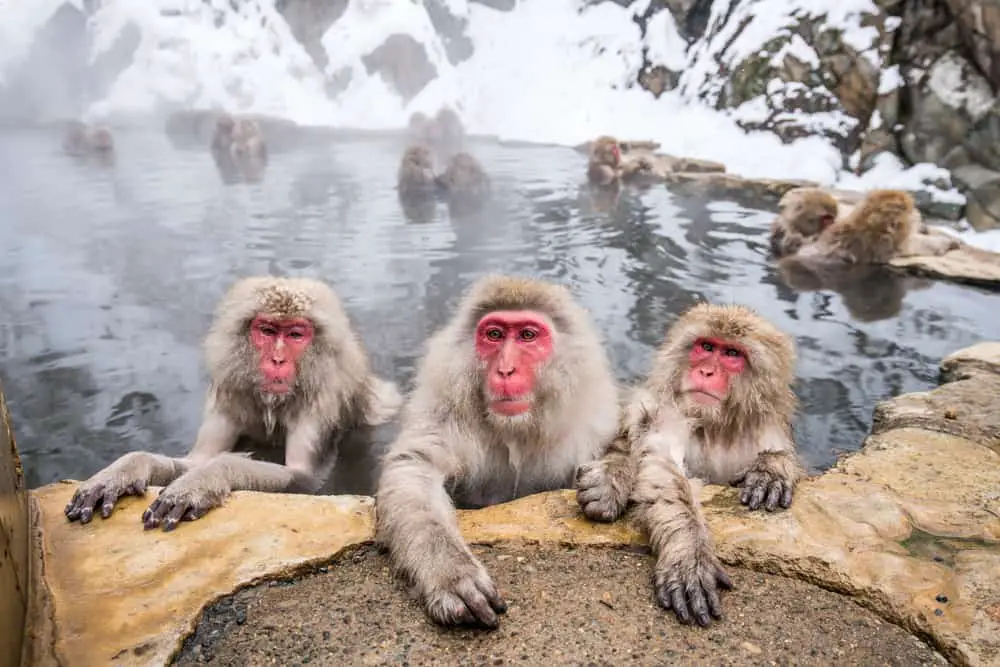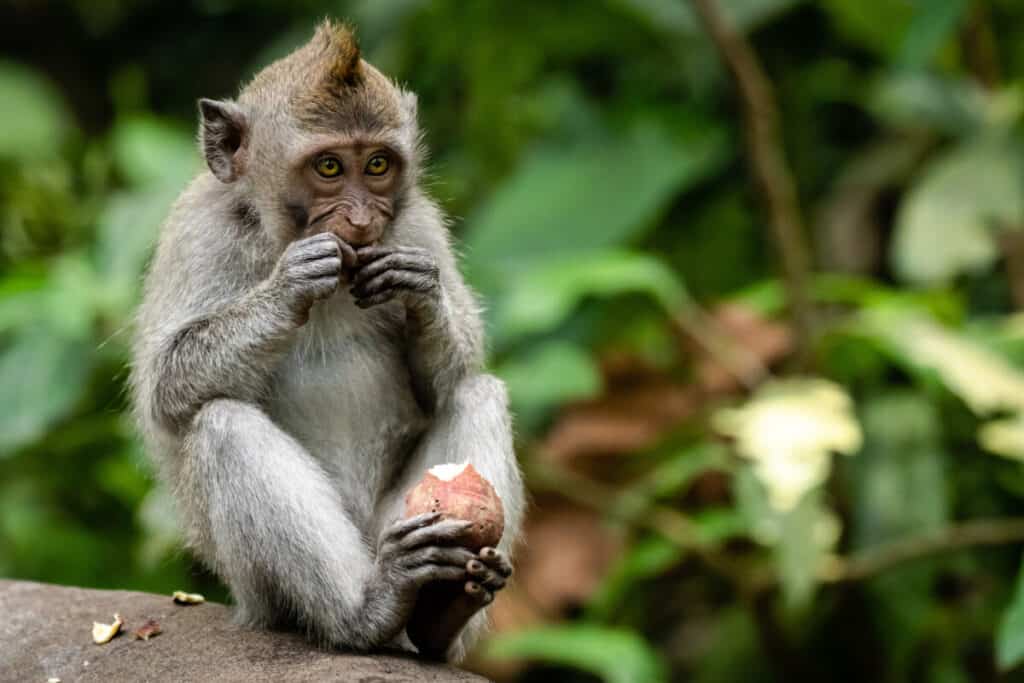Macaques are a genus of Old World monkeys that range in size from small to medium, with long tails and distinctive facial features. They live in various habitats ranging from forests to grasslands and have adapted to different ecological niches within these environments.
Macaque species are found across Asia, including India, China, Japan, and Southeast Asia. They are known for their intelligence and ability to adapt to changing environments. In addition, they play an important role in medical research due to their genetic similarity to humans.
Macaques exhibit complex social structures and behavior patterns, making them an important species for the study of primate behavior. However, macaque populations face threats such as habitat loss, hunting by humans for food or medicinal purposes, and capture for use in biomedical research. Understanding the biology and behavior of macaques is crucial to developing effective conservation strategies for these primates.

Description And Classification Of Macaques
Macaques are a type of Old World monkey that belong to the genus Macaca. They are found naturally in Asia, particularly in regions such as China, Japan and India. These primates have physical characteristics that make them easily identifiable – they have short tails and a stocky build with fur ranging from brown to grey depending on the species. Their faces often feature distinctive markings around their eyes or muzzle.
In terms of diet and feeding habits, macaques are omnivores but mainly rely on plant-based foods such as fruits, leaves, flowers, and seeds. However, they also consume insects, small vertebrates like birds and rodents, and even other monkeys when food is scarce.
Some species of macaque have adapted to urban environments where they utilize human sources of food such as garbage dumps or crops grown by farmers. Overall, their ability to adjust their diets based on availability allows them to thrive in various environments despite human encroachment into natural habitats.
There are 22 species of macaques. Here are some of them.
| Macaque Species | Scientific Name | Distribution |
|---|---|---|
| Barbary Macaque | Macaca sylvanus | North Africa (Morocco and Algeria) |
| Japanese Macaque | Macaca fuscata | Japan |
| Rhesus Macaque | Macaca mulatta | South Asia (India, Nepal, Bhutan, Bangladesh) and Southeast Asia |
| Tibetan Macaque | Macaca thibetana | China (Tibetan Plateau) |
| Assam Macaque | Macaca assamensis | Northeast India, Bhutan, Myanmar, and China |
| Bonnet Macaque | Macaca radiata | South India |
| Formosan Rock Macaque | Macaca cyclopis | Taiwan |
| Sulawesi Crested Macaque | Macaca nigra | Sulawesi (Indonesia) |
| Lion-tailed Macaque | Macaca silenus | Western Ghats in India |
Habitat And Distribution Of Macaques
Macaques are primates that belong to the Old World monkey family Cercopithecidae. These animals have a wide distribution range and can be found in various habitats across Asia, from rainforests to grasslands. They inhabit countries such as India, China, Indonesia, Japan, and Thailand.
The natural predators of macaques include large carnivorous mammals such as leopards and tigers. Furthermore, habitat destruction and hunting by humans pose significant threats to their survival. As a result, some species of macaques are classified as endangered or vulnerable according to the International Union for Conservation of Nature (IUCN). To ensure their conservation status does not worsen any further, it is essential to take measures like habitat protection and anti-poaching efforts.
- Macaques live in social groups ranging from 10-200 individuals.
- Some species of macaques are considered pests because they often raid crops and gardens.
- The lifespan of macaques varies depending on the species but ranges between 15-25 years.
- Different species of macaques exhibit diverse physical characteristics including varying fur coloration and tail length.
Adaptations Of Macaques To Different Environments
Macaques are highly adaptable primates that have managed to thrive in a variety of environments across the world. While their habitat and distribution play an important role in this, their ability to adapt is also driven by several key factors such as their cultural practices and feeding habits.
One way macaques can adapt to different environments is through their cultural practices, which often include unique behaviors passed down from one generation to another. For example, some groups of macaques have been observed washing food before eating it, while others use tools like sticks or stones to crack open nuts or shells. These cultural practices help macaques survive by allowing them to access new food sources or better protect themselves from predators.
Another important factor that drives adaptation in macaques is their feeding habits. Different species of macaque have evolved to eat different types of foods depending on what’s available in their environment. Some primarily eat fruit and leaves, while others consume insects, small animals, and even other primates. By being opportunistic feeders with a diverse diet, macaques are able to find sustenance even in challenging environments where resources may be scarce.
| Species | Habitat | Feeding Habits |
|---|---|---|
| Japanese Macaque (Snow Monkey) | Japan’s northern islands | Mostly herbivorous; eats fruits and vegetables but will also eat insects and fish |
| Rhesus Macaque | South Asia | Omnivores; eats plants, insects, small mammals, and carrion |
| Barbary Macaque | North Africa & Gibraltar | Herbivores; eats mostly fruits but will also consume seeds and leaves |
In conclusion, macaques’ ability to adapt is critical for their survival in various habitats around the world. Their cultural practices allow them to learn new ways of finding food or protecting themselves from danger whereas their diverse feeding habits enable them to make do with whatever they can find in any given environment. By being able to make the most of their surroundings, macaques have managed to thrive in a wide range of habitats while remaining one of the most fascinating primates on earth.
Importance Of Macaques In Medical Research
Macaques have been widely used in medical research due to their similarities with humans, especially regarding the immune system and physiology. They are commonly utilized for vaccine development, infectious disease studies, neurology research, and drug testing. These animals play a crucial role in providing valuable insights into human diseases that cannot be obtained through other models.
Additionally, macaques offer an opportunity to test potential treatments before administering them to humans. Despite the benefits of using macaques in medical research, ethical considerations must be taken into account. Some argue that animal experimentation is cruel and unnecessary when alternative testing methods exist. Others believe that it is necessary to use non-human primates for certain types of research as there are no viable alternatives available yet.
Researchers who use these animals must adhere to strict regulations set forth by governing bodies such as the Institutional Animal Care and Use Committee (IACUC) or the National Institutes of Health (NIH). These guidelines aim to ensure that ethical standards are met while also promoting scientific advancement. Ultimately, researchers should strive towards minimizing any harm inflicted on these animals during experiments while simultaneously advancing medicine via responsible practices.
Social Structures And Behavior Of Macaques
Dominance hierarchy is a crucial aspect of macaque social structure. Within a group, there is always an established order where some individuals are dominant over others. This hierarchy is determined through aggressive interactions and displays such as threats, fights, and vocalizations. Dominant individuals have priority access to resources such as food and mates and may exert control over subordinates by limiting their access to these resources. The dominance hierarchy in macaques is not fixed but can change due to various factors such as age or changes in the environment.
Grooming behavior also plays a significant role in macaque social structures. Grooming involves one individual picking through another’s fur with its fingers or mouth, removing dirt, parasites, and dead skin cells while forming strong relationships between them. It helps establish bonds within groups which reduce tension and aggression among members. Additionally, grooming has been shown to increase levels of oxytocin (the hormone associated with bonding) in both the groomer and the groomed monkey.
Macaque groups tend to be formed around matrilines – females who are related through descent from a common female ancestor- so many grooming behaviors occur between closely related females that live together for several years before dispersal.
Threats To Macaque Populations And Conservation Efforts
Throughout history, macaque populations have faced numerous threats that have led to their decline. One of the significant factors is poaching, where these primates are hunted for meat and body parts used in traditional medicine. This illegal trade has significantly impacted the population size of macaques worldwide.
In addition, habitat loss due to deforestation and human activities such as agriculture and urbanization has reduced macaque’s natural habitats leading to a decrease in their numbers.
To mitigate these threats, various conservation efforts have been put in place. Poaching prevention measures include law enforcement patrols in protected areas, awareness campaigns on the negative effects of poaching on wildlife, and severe penalties for those caught engaging in this activity.
Habitat restoration initiatives involve reforestation programs aimed at restoring degraded forest lands while also creating new corridors for easy movement of macaques between different habitats. Additionally, education programs targeting local communities living near macaque habitats can help reduce human-wildlife conflicts and promote coexistence between humans and these primates.
3 ways conservationists can support Macaque Populations:
- Increase protection by establishing more national parks dedicated to preserving them.
- Collaboration with other organizations or governments globally to raise awareness about the importance of conserving Macaque populations.
- Support research into understanding how climate change affects these animals’ lives so they can be better protected from its impacts over time.
By implementing such measures, we can ensure that future generations will not miss out on experiencing the beauty of these fascinating creatures in their natural habitats.

Conclusion
Macaques are a diverse group of primates that have adapted to various environments from forests to deserts. They belong to the family Cercopithecidae and can be classified into 23 different species based on their physical features, behavior, and habitat.
Macaques play significant roles in medical research due to their close genetic similarity with humans. However, they face numerous threats such as habitat loss, poaching for meat or pets, and human-wildlife conflict.
The social structures and behaviors of macaques vary across species but typically involve complex hierarchies and communication systems. They also exhibit remarkable adaptations such as cold tolerance, swimming ability, and tool use in response to environmental challenges.
Conservation efforts involving community-based programs, protected areas management, and education initiatives aim to reduce these threats’ impact on macaque populations worldwide.
In conclusion, macaques are fascinating animals that have contributed significantly to our understanding of primate evolution, physiology, and cognitive abilities. Their ecological flexibility and adaptation strategies make them valuable subjects for scientific studies while highlighting the importance of protecting their habitats from anthropogenic activities. As the saying goes: ‘We do not inherit the earth from our ancestors; we borrow it from our children.’ It is crucial that we take responsibility for preserving biodiversity by supporting conservation measures that sustain healthy ecosystems for future generations.

